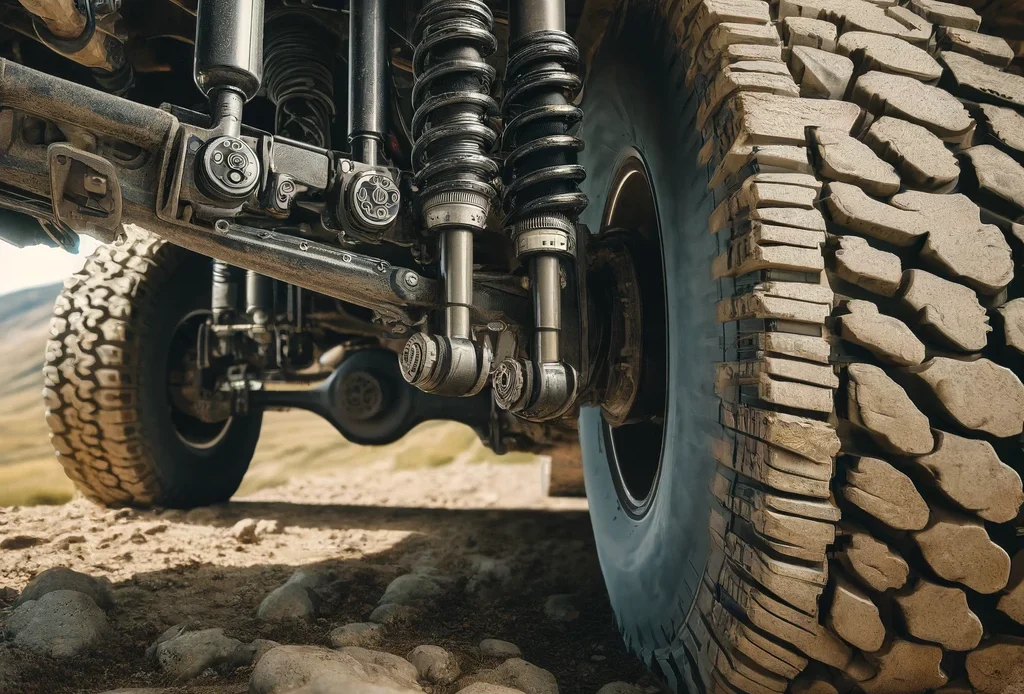Mastering the Road A Comprehensive Guide to Air Suspension Kits for Tailoring Your Truck’s Ride
Introduction to Air Suspension Kits
In the realm of truck customization, few enhancements wield as much transformative power as air suspension kits. These innovative systems have revolutionized the way enthusiasts tailor their truck’s ride to suit their specific needs and preferences. But what exactly are air suspension kits, and why are they such a game-changer?
Air suspension kits, in essence, replace traditional coil springs or leaf springs with air springs, which are inflatable bags made of durable materials like rubber or polyurethane. These air springs are connected to an air compressor and control system, allowing drivers to adjust the ride height and stiffness of their truck with precision.
The benefits of installing air suspension kits are manifold. Beyond the obvious aesthetic appeal of a lowered or lifted ride, these systems offer tangible improvements in performance, comfort, and versatility. Whether you’re hauling heavy loads, navigating rough terrain, or simply cruising down the highway, air suspension ensures a smoother, more controlled ride.
In this comprehensive guide, we’ll delve deep into the world of air suspension kits, exploring how they work, the various types available, installation processes, maintenance tips, and more. By the end, you’ll have a newfound understanding of how air suspension can elevate your truck’s performance and enhance your driving experience. So buckle up as we embark on this journey to master the road with air suspension kits.
Understanding How Air Suspension Works
To truly harness the power of air suspension kits for your truck, it’s crucial to understand the mechanics behind this cutting-edge technology. At its core, air suspension operates on a simple yet ingenious principle: using compressed air to support the vehicle’s weight and absorb shocks. Let’s delve deeper into how this system works its magic.
Air suspension systems consist of several key components, including air springs, air compressors, air reservoirs, and control systems. The heart of the system lies in the air springs, which replace traditional coil or leaf springs. These inflatable bags are strategically positioned at each corner of the vehicle, providing support and cushioning.
When the vehicle is in motion, the air compressor pumps air into the springs, increasing the pressure to support the weight of the truck and its cargo. Conversely, when the vehicle encounters bumps or uneven terrain, the control system releases air from the springs to soften the impact and maintain a smooth ride.
One of the most significant advantages of air suspension is its ability to dynamically adjust ride height and stiffness on the fly. This adaptive functionality allows drivers to raise the suspension for off-road adventures or lower it for improved aerodynamics and handling on the highway.
In summary, air suspension systems offer a sophisticated solution to the age-old challenges of vehicle suspension. By harnessing the power of compressed air, these systems deliver unmatched comfort, performance, and versatility on the road. So buckle up and prepare to elevate your driving experience with air suspension technology.
Benefits of Installing Air Suspension Kits
The decision to install an air suspension kit on your truck isn’t just about aesthetics—it’s a strategic investment in enhancing your vehicle’s performance and comfort. From smoother rides to improved handling, air suspension kits offer a host of benefits that set them apart from traditional suspension systems. Let’s explore why more and more truck enthusiasts are opting for air suspension.
- Customizable Ride Height: One of the standout features of air suspension kits is their ability to adjust ride height on the fly. Whether you’re towing a heavy load or navigating rough terrain, you can easily raise or lower your truck to suit the driving conditions.
- Improved Handling: By maintaining optimal ride height and stiffness, air suspension systems minimize body roll and improve overall stability, especially during cornering and sudden maneuvers. This translates to a safer and more enjoyable driving experience.
- Enhanced Comfort: Say goodbye to jolts and bumps. With air suspension, you’ll enjoy a smoother, more cushioned ride, even on the roughest roads. Plus, the ability to fine-tune suspension settings allows you to tailor your comfort level to your liking.
- Versatility: Whether you’re a weekend warrior or a daily commuter, air suspension kits offer unmatched versatility. From off-road adventures to city cruising, you’ll appreciate the adaptability and performance of your air-suspended truck.
- Increased Towing Capacity: Need to haul a heavy trailer or equipment? Air suspension kits can bolster your truck’s towing capacity by providing additional support and stability, ensuring a safer and more controlled towing experience.
In conclusion, installing an air suspension kit is more than just a cosmetic upgrade—it’s a strategic decision to enhance your truck’s performance, comfort, and versatility. So why settle for a standard suspension system when you can elevate your ride with air suspension technology?
Types of Air Suspension Kits Available
When it comes to air suspension kits for your truck, one size definitely doesn’t fit all. With a variety of options on the market, it’s essential to understand the different types available and their respective features. Let’s take a closer look at the various types of air suspension kits to help you make an informed decision for your truck.
- Full Air Suspension Systems: These comprehensive kits replace both the front and rear suspension systems with air springs, providing complete control over your truck’s ride height and stiffness. Full air suspension systems offer the ultimate in customization and performance but may require more extensive installation.
- Air Springs: If you’re looking to upgrade your existing suspension without a full overhaul, air springs are an excellent option. These individual airbags can be installed in place of your truck’s stock coil or leaf springs, offering adjustable support and improved ride quality.
- Airbag Suspension Systems: Similar to air springs, airbag suspension systems utilize airbags to support the vehicle’s weight. However, these kits typically include additional components such as air compressors, valves, and control modules for enhanced adjustability and convenience.
- Coilover Air Suspension: Combining the benefits of traditional coilover shocks with air springs, coilover air suspension kits offer precise control over ride height and damping characteristics. These kits are popular among performance enthusiasts seeking improved handling and cornering ability.
- Universal Air Suspension Kits: Designed to fit a wide range of vehicles, universal air suspension kits offer flexibility and compatibility for trucks of various makes and models. While they may require some customization during installation, universal kits provide an affordable option for upgrading your truck’s suspension.
By understanding the different types of air suspension kits available, you can select the one that best suits your truck’s needs and your driving preferences. Whether you prioritize performance, comfort, or versatility, there’s an air suspension solution out there to elevate your ride to new heights.
Installation Process of Air Suspension Kits
Embarking on the journey of installing an air suspension kit can be daunting, but with the right guidance and preparation, it’s a manageable task. In this chapter, we’ll walk you through the step-by-step installation process, from gathering the necessary tools to completing the final adjustments.
- Preparation: Before diving into the installation, ensure you have all the required tools and equipment on hand. This typically includes a jack, jack stands, wrenches, sockets, and possibly specialized tools depending on your specific kit.
- Vehicle Preparation: Start by safely raising your truck and securing it with jack stands. Then, remove the wheels and disconnect any components that obstruct access to the suspension, such as brake lines or sway bars.
- Old Suspension Removal: Depending on the type of kit you’re installing, you may need to remove the existing suspension components, such as coil springs or leaf springs. Follow the manufacturer’s instructions carefully to avoid damaging other parts of the vehicle.
- New Component Installation: With the old suspension removed, it’s time to install the new air suspension components. Begin by mounting the air springs or airbags in their designated locations, ensuring they are securely attached and aligned properly.
- Plumbing and Wiring: Connect the air springs to the air compressor and control system using the provided air lines and fittings. Additionally, wire the control module according to the manufacturer’s instructions, ensuring proper functionality and integration with your truck’s electrical system.
- Testing and Adjustment: Once everything is installed, perform a thorough inspection to ensure all connections are secure and components are properly aligned. Then, lower the truck off the jack stands and test the air suspension system for leaks, abnormal noises, and proper functionality. Make any necessary adjustments to ride height and stiffness settings to achieve the desired ride quality.
By following these steps diligently and taking your time, you can successfully install an air suspension kit on your truck and enjoy the benefits of a customized ride. However, if you’re not confident in your mechanical abilities, it’s always best to consult a professional mechanic for assistance.
Maintenance and Care Tips for Air Suspension Kits
Just like any other component of your truck, air suspension systems require regular maintenance to ensure optimal performance and longevity. In this chapter, we’ll discuss essential maintenance tasks and care tips to keep your air suspension kit in top condition.
- Inspect for Leaks: Regularly check the air lines, fittings, and air springs for any signs of leaks. Look for hissing sounds, visible damage, or drops in ride height, as these may indicate air leakage.
- Lubricate Moving Parts: Keep the moving components of your air suspension system, such as the air springs and control arms, well-lubricated to prevent friction and premature wear. Use a suitable lubricant recommended by the manufacturer.
- Check Air Compressor and Components: Ensure the air compressor is functioning correctly by listening for abnormal noises or irregular operation. Inspect the compressor, air reservoir, and control module for any signs of damage or wear.
- Inspect Electrical Connections: Verify that all electrical connections, including wiring harnesses and control modules, are secure and free from corrosion. Clean any corroded terminals and apply dielectric grease to prevent future corrosion.
- Monitor Ride Height: Periodically check the ride height of your truck to ensure it remains within the desired range. Adjust the air pressure in the air springs as needed to maintain proper ride height and suspension stiffness.
- Perform Regular System Checks: Conduct routine system checks to test the functionality of the air suspension system. This includes cycling the system through its various modes, checking for error codes, and verifying proper operation of the control module.
- Follow Manufacturer Recommendations: Adhere to the maintenance schedule and recommendations provided by the manufacturer of your air suspension kit. This may include specific intervals for servicing components or replacing wear items.
By following these maintenance and care tips, you can extend the life of your air suspension kit and ensure consistent performance for years to come. Remember that proactive maintenance is key to avoiding costly repairs and maximizing the enjoyment of your customized ride.
Cost Considerations and Budgeting for Air Suspension Kits
Investing in an air suspension kit for your truck can significantly enhance its performance and aesthetics, but it’s essential to consider the associated costs and budget accordingly. In this chapter, we’ll explore the various factors that influence the cost of air suspension kits and provide tips for budgeting effectively.
- Kit Type and Complexity: The cost of an air suspension kit can vary depending on its type and complexity. Full air suspension systems with comprehensive features and adjustability options typically command a higher price tag compared to simpler kits like air springs or universal setups.
- Brand and Quality: Like most automotive components, air suspension kits come in a range of brands and quality levels. While it may be tempting to opt for a cheaper option, investing in a reputable brand known for quality and reliability can save you money in the long run by reducing the risk of premature failure or costly repairs.
- Installation Costs: In addition to the cost of the kit itself, you’ll need to factor in installation expenses. Professional installation by a certified mechanic ensures proper fitment and functionality but comes with a labor cost. Alternatively, if you have the necessary tools and mechanical skills, you may choose to install the kit yourself to save on labor fees.
- Accessories and Add-Ons: Consider any additional accessories or add-ons you may want to complement your air suspension kit, such as upgraded shocks, air management systems, or electronic controllers. These extras can enhance performance and convenience but will add to the overall cost of the project.
- Long-Term Maintenance: Don’t forget to budget for long-term maintenance and upkeep of your air suspension system. While air suspension kits are generally durable and reliable, they may require periodic servicing, component replacements, or upgrades over time.
- Compare Prices and Shop Around: Take the time to research different air suspension kits, compare prices from multiple vendors, and read reviews from other truck enthusiasts. Look for promotions, discounts, or package deals that can help offset the upfront cost of the kit.
By carefully considering these cost considerations and budgeting accordingly, you can make an informed decision when purchasing an air suspension kit for your truck. Remember that while upfront costs are important, the value and performance that a quality air suspension kit provides can justify the investment in the long run.
Conclusion: Elevate Your Truck’s Performance with Air Suspension Kits
As we conclude our exploration of air suspension kits for trucks, it’s clear that these innovative systems offer far more than just a cosmetic upgrade. From customizable ride height to enhanced handling and comfort, air suspension kits have the power to transform your truck into a versatile and capable machine.
By understanding how air suspension works, the benefits it offers, and the various types available, you can select the perfect kit to suit your driving needs and preferences. Whether you’re a weekend warrior seeking off-road adventures or a daily commuter craving a smoother ride, air suspension technology has something to offer everyone.
But installing an air suspension kit is just the beginning. Regular maintenance, proper care, and budgeting for associated costs are essential to maximizing the longevity and performance of your air suspension system. By staying proactive and investing in quality components, you can enjoy years of trouble-free operation and unparalleled driving enjoyment.
So why settle for a stock suspension system when you can elevate your truck’s performance and aesthetics with air suspension technology? Take the plunge, invest in an air suspension kit, and experience the road like never before. Your customized ride awaits—so go ahead, elevate your truck to new heights!
For detailed information, you can contact us at Air Suspension Kits


